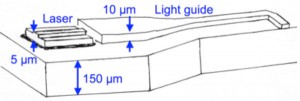Waveguide Micro-probes for Optical Control of Excitable Cells

Figure 1: A CAD drawing of a light-guide probe with eight laser inputs (an actual probe will have many more inputs and outputs). The output of the waveguide can be seen more clearly in Figure 2; note that the drawing in Figure 2 is not to scale and an actual probe will be much longer.
Professor Ed Boyden uses light to precisely control neural activity. His lab has invented safe, effective ways to deliver light-gated membrane proteins to neurons and other excitable cells (e.g., muscle, immune cells, pancreatic cells, etc.) in an enduring fashion, thus making the cells permanently sensitive to being activated or silenced by millisecond-timescale pulses of blue and yellow light, respectively [1]. This ability to modulate neural activity with a temporal precision that approaches that of the neural code itself holds great promise for human health, and his lab has developed animal models of epilepsy and Parkinson’s disease to explore the use of optical control to develop new therapies. His work has attracted international attention and appeared in numerous articles, including a recent piece in the Science Times section of The New York Times [2] and a profile of his lab for the Discovery Channel’s “Top 5 Science Stories of the Year.”

Figure 2: A perspective sketch of a platelet laser diode aligned with the input of a multi-mode rectangular dielectric waveguide and bonded on a contact pad. This cartoon illustrates the type of micro-scale assembly and integration proposed for the light-guide probe.
Professors Boyden and Fonstad have initiated a collaborative effort to use heterogeneous integration techniques developed in Fonstad’s laboratory to construct miniature linear probes to deliver light to activate and silence neural target regions along their length as desired. The goal is to develop mass-fabricatable multiple light guide microstructures produced using standard microfabrication techniques. Each probe is a 200- to 250-micron-wide insertable micro-structure comprising many miniature lightguides running in parallel and delivering light to many points along the axis of insertion. Such a design maximizes the flexibility and power of optical neural control while minimizing tissue damage. If 2-D arrays of such probes are built, multiple colors of light can be delivered to 3-dimensional patterns in the brain, at the resolution of tens to hundreds of microns, thus furthering the causal analysis of complex neural circuits and dynamics. Such devices will allow the substrates that causally contribute to neurological and psychiatric disorders to be systematically analyzed via causal neural control tools. Given recent efforts to test such reagents in nonhuman primates, these devices may also enable a new generation of optical neural control prosthetics, contributing directly to the alleviation of intractable brain disorders.
The initial light-guide structures have been fabricated from silicon oxynitride clad with silicon dioxide, and tests show good transmission of red light with no visible loss in the taper and bend regions of the patterns. Significantly, the novel 90˚ bend invented to direct light laterally out the side of the narrow probe (visible in both Figures 1 and 2) appears to function as designed, although much more work is needed to fully quantify the performance. The test mask contains a variety of guide structures, and a series of measurements is underway to quantify the losses in straight sections of various widths, through different radius bends and sections with different degrees of taper, and around the 90˚ bends. The optical sources for initial tests with the probe will be independent laser modules coupled to one end of a fiber-optic ribbon cable. The other end of the ribbon cable will be butt-coupled to the inputs of the probe. This will allow for increased modularity and control in initial probe-testing. Work on the fabrication of visible-emitting platelet laser diodes to be integrated with the guides will also begin soon.
References
- X. Han and E.S. Boyden, “Multiple-Color Optical Activation, Silencing, and Desynchronization of Neural Activity, with Single-Spike Temporal Resolution,” PLoS ONE, vol. 2, no. 3, p. e299, March 2007. [↩]
- I. Chen, “The Beam of Light That Flips a Switch That Turns on the Brain,” New York Times, Science Section, p. D1, Aug. 14, 2007. [↩]